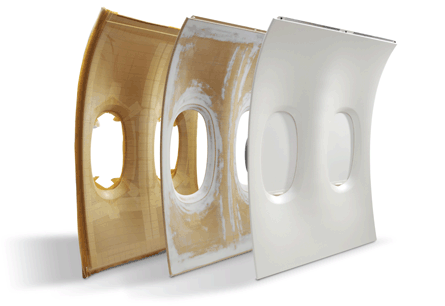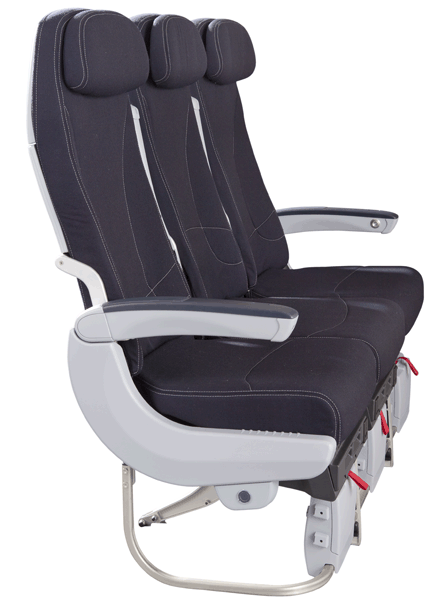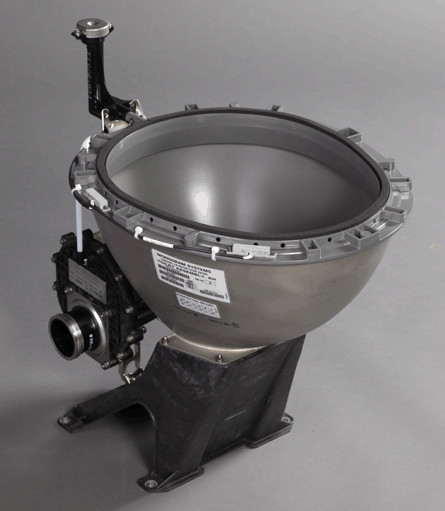Once again, fuel prices are heading steeply north and aircraft manufacturers as well as operators are under pressure to slash weight for greater efficiency. But with travellers demanding more elaborate and comfortable accommodation, optimising the passenger cabin is a complex task.
Lightweight construction has always been a priority in aircraft design, no matter what fuel prices are. Minimising weight is central in achieving the optimum ratio between payload and range for an aircraft and, consequently, low fuel consumption. What the rising kerosene price has certainly led to, however, is ever more sophisticated and expensive technology being employed to cut weight and reduce fuel burn.
With each new aircraft programme, around 10% has been shaved off the weight of interior equipment that Diehl Aerosystems has produced. The German company manufactures cabin linings, luggage bins, air distribution systems, lighting and complete monuments such as crew rest compartments and lavatories.
 |
|---|
© DiehlDiehl's lean range spans sidewalls |
While most of weight reductions have in the past been achieved by employing more modern, lightweight materials, the future objective is to better combine different functional parts, says Diehl Aerosystems president Rainer von Borstel. An example is the integration of electronic components into cabin lining elements.
Another aim is to concentrate "more thoroughly" on the aftermarket and offer customers equipment that is suitable for interior upgrades. "We are looking closely at expanding our share of the cabin retrofit market," says von Borstel. "Obviously, a retrofit product can only be successful if it is more attractive than the original component."
Seats are a focus of cabin weight-loss efforts. In December, Lufthansa introduced a new lightweight seat for the business and economy classes of its European short- and medium-haul fleet. The seat is also deployed by Lufthansa subsidiaries Austrian Airlines, Brussels Airlines and Swiss International Air Lines.
NETTING MATERIAL
The seat's Germany-based manufacturer Recaro replaced almost all conventional foam padding with an elastic polyester netting material, which made the seat-back profile much thinner. With the literature pocket moving up from the knee area to a position above the tray table, it became possible to achieve approximately 4cm (1.6in) more legroom while reducing the seat pitch from 32in to 30in.
Lufthansa installed additional seat rows and increased capacity on, for example, its Airbus A320s from 150 to 168 seats. With around 2,000 surplus seats, fleet-wide capacity has been increased by 8% - equivalent to a dozen additional A320s.
Weight has been reduced by around 30% to 11kg (24lb) per single seat due to the absence of foam, a new armrest and larger hole in the seat-belt buckle. The new passenger accommodation has slashed around 300kg off a Boeing 737's empty weight. Across the entire fleet, savings total 131t.
The German airline plans to introduce a new long-haul economy-class seat with the service entry of its Boeing 747-8 next year.
Meanwhile, maintenance subsidiary Lufthansa Technik is working on a future first-class/VIP seat at its cabin innovation centre in Hamburg. "Developing first class/VIP seats is not an area that the manufacturers are exactly fighting for because unit volume is too small for them," says Franz-Josef Kirschfink, director of technology projects.
The company plans to produce, in around two years' time, a prototype 20-25% lighter than comparable models. The other priority is to build the seat in a modular manner that allows customisation to airlines' requirements, such as the installation of individual armrests, without adding components and increasing the overall weight. But the company is "not yet" working with a seat manufacturer on this project, says Kirschfink.
 |
|---|
© B/E AerospaceB/E's latest Pinnacle seat saves 4.5kg |
Meanwhile, Florida-headquartered B/E Aerospace is considering whether to offer its Pinnacle economy-class seat with an elastic net-based seating material instead of the current foam padding. Introduced in 2009, the seat is "a good 10lb" - 15-20% - lighter than its predecessor model in triple configuration, says Alex Pozzi, vice-president of research and development of seating products.
While certain that long-haul seats need foam to provide "an extra level of comfort", Pozzi acknowledges that a number of airlines have moved to cushion-less passenger accommodation on short- to medium-haul aircraft in what he calls "de-featuring" for the sake of light weight. "If that trend continues and is accepted by the market, then I think you would see us move into that market segment with an adaptation of the platform."
The company pursues different avenues to cut weight, such as reducing process variations to manufacture more consistent and precise parts for a lean construction with tight tolerances; using high-quality materials with better strength-to-weight ratios and reducing part count to avoid joints that would require additional strengthening; and optimising the overall architecture, for example by avoiding large lever arms that generate unnecessarily high forces.
But seats are not the only cabin item that can lose a few kilogrammes.
OXYGEN BOTTLES
Swedish charter carrier TUIfly Nordic has selected the Pinnacle seat for two new 737-800s being delivered this year, and will cut the empty weight of the 189-passenger aircraft by nearly 340kg compared with its older 737NGs. But the company also looked at other areas to lose weight, including new service trolleys, lightweight carpets and composite oxygen bottles.
The latter not only shave off 16kg per aircraft but are less expensive than standard steel bottles and have lower maintenance costs.
However, low weight does not always translate to low cost. The airline once selected a super-lightweight carpet only to find that the manufacturer had minimised the structure so much that it did not withstand the strains of daily passenger airline service, necessitating premature replacement.
Achieving low weight and maintenance at low cost usually is "utopian", says Robert Kostic, TUIfly Nordic's cabin engineering and interiors specialist. "Many times, we will see a higher purchase price, but with some beneficial returns down the line - lower maintenance costs, improved reliability or a higher customer satisfaction."
 |
|---|
© Zodiac AerospaceZodiac unit Monogram Systems produces fresh water tanks and vacuum waste systems |
While airlines have become much more conscious of weight savings, not many have made substantial changes during cabin refurbishment programmes, says Marie-Louise Nordlund, commercial director at Sollentuna Cabin Interiors in Stockholm. This is partly reflective of the economic environment in recent years and of requirements for extensive testing if, for example, an airline wants to cover an existing seat with a new cover material. In this context, many airlines have resorted to simple measures such as using lightweight carpets.
US manufacturer Timco is looking to extend its "FeatherWeight" retrofit galleys and lavatories for Boeing 767s to other aircraft. "We are anxious to move into all segments, from narrowbodies to the largest of widebodies... not just with Boeing but Airbus as well," says Leonard Kazmerski, vice-president marketing and business development.
Aside from weight reduction, greater modularity is the other main objective for galleys. Operators should be able to use the compartments flexibly and move around inserts within the basic framework without concern for structural restrictions or need for expensive testing. The challenge in such a universal set-up is to determine where the load-bearing elements need to be located and other areas where weight can be minimised.
Being able to design and test new equipment on the computer before any metal needs to be cut has been central to developing lightweight equipment, says Kazmerski. Another critical factor has been increased access to - and reduced cost of - computer numerically controlled manufacturing equipment, used to produce ever more complex parts.
German galley manufacturer Sell, which Zodiac Aerospace acquired last September, is working on a generation of lightweight galley inserts. The company wants to cut up to 26% of the individual units' mass, with a steam oven losing most weight in relative terms, from 22.5kg to 16.5kg.
Thinner walls, new insulation materials, lighter motors (for ovens) and new bonding techniques - such as the use of glue rather than metal screws - are among the innovations. Since the 1980s, the weight of comparable galleys has been reduced by 20-25%, says Sell. This is despite equipment having become more complex and component count increasing, especially in the area of electrical installations and protection.
Zodiac subsidiary Driessen has nearly halved the weight of its full-size service trolleys, from 28kg in 1996 to the 15kg of this year's Hybride incarnation. The company has moved gradually from steel profiles, via aluminium, to composites. With 30-40 trolleys aboard a widebody, such weight loss produces big savings - and it can give breathing space to the new essentials: first-class cabins, on-board showers and ever more astonishing in-flight entertainment.
Source: Flight International
















